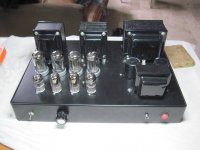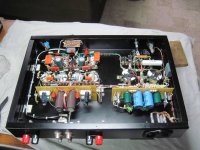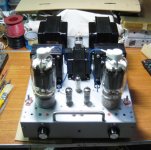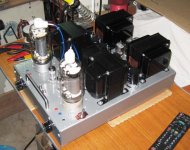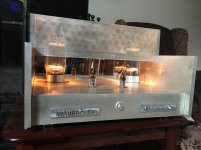No hum, but plenty of intermodulation distortion. Have a look sometime with an FFT, you'll be surprised. It's why tubelab, me, and others advocate for proper DC heating even though you can seemingly get away without it with 2.5V tubes.
that could very well be, but the owners are happy, i am happy for them....
4P1L is still cheap, and easy to parallel...
yes, i did one a couple of years ago....owner was very happy, this one used dc heater supplies....all russian tubes...
dc heating used plain crc filters....
Attachments
4P1L is still cheap, and easy to parallel...
Yes - I ditched 300b, 2a3, 6C4C etc. for 4P1L outputs. Very pleased.
I'm curious about the GM70 and the 813 but never built with either. Really don't want to use high voltages. I'd be interested at 400v but in summer these tubes would be pretty hot....
I have a few 46 I could try out. No doubt in PSE. But not sure what the improvement would be over 4P1Ls. Maybe nothing.
Yes - I ditched 300b, 2a3, 6C4C etc. for 4P1L outputs. Very pleased.
I'm curious about the GM70 and the 813 but never built with either. Really don't want to use high voltages. I'd be interested at 400v but in summer these tubes would be pretty hot....
I have a few 46 I could try out. No doubt in PSE. But not sure what the improvement would be over 4P1Ls. Maybe nothing.
i have an 813 set built and ready, but the 1kv scares the hell out of me...
one day i will get enough courage to power it up....
Attachments
"La bestia parda".
I have an other 813 ampli, but is for RF use only.
For audio I like the tinny triodes or the EL34 family max
I have an other 813 ampli, but is for RF use only.
For audio I like the tinny triodes or the EL34 family max
Reading up on everything at my disposal on 300b and while some like em' and some hate I'm heading in the 300b direction. I have a 2a3 & a 45 amp now so may as well try a 300b.
I have a few 46 I could try out. No doubt in PSE. But not sure what the improvement would be over 4P1Ls. Maybe nothing.
Visually it surely is quite some improvement at expense of beefier filament!😀
For PSE you have to have a good match to take advantage and the 4P1L clearly scores a point here, unless you have enough 46's.....
In general the 46 can give you a bit more power (up to 3W with power drive and low loss OT) and on average is probably a bit more linear as a power tube....if truly NOS.
Despite what datasheet says you can use it as a 10W triode (up to 300V anode voltage) like the 45. You can also ask Ale about this for confirmation....
Reading up on everything at my disposal on 300b and while some like em' and some hate I'm heading in the 300b direction. I have a 2a3 & a 45 amp now so may as well try a 300b.
I don't hate the 300B, quite the contrary. I have only found that if I have to use it for getting the typical 8-10W the 2A3 PSE is more convenient.
If you want to go for a SE have a look at the EML 300B XLS. It is expensive but quality is good. If you use it like a WE300B will last longer; If you use at 43W plate dissipation will last like a WE 300B but will get 50% more power....max plate dissipation is 55W....
At 43W disspation with 14-15 W output power at 3% THD it will be in another league respect to a 2A3 PSE.
i have an 813 set built and ready, but the 1kv scares the hell out of me...
one day i will get enough courage to power it up....
When I fired up the Midlife Crisis 833C amps the first time I had a fire extinguisher next to me and I pushed the power button with a 3 foot long wooden stick. My heart rate was definitely accelerated!
Three years of reliable use later, it's like turning on the toaster to me. Works every time.
i have an 813 set built and ready, but the 1kv scares the hell out of me...
one day i will get enough courage to power it up....
It's a waste if you don't power it up. Buy a robot that you can teach to do it for you!!😀
Maiko,
The article “Paralleling Tubes Effects” was in Glass Audio, Volume 12, Number 5, year 2000.
I wrote the article with the assistance and the lab of Matt Kamna, and the math assistance of Ken Boehlke. I knew what math was needed, but I wanted an expert to be sure it was completely correct.
I do not believe the article is on the web, but if anybody knows, please post the link in this thread.
We tested 10 new, and 20 used 6SN7s (a very linear dual triode). We tested single and paralleled triodes in the same envelope, and single and paralleled triodes from 2 separate envelopes. We collected 600 measurements, and collated them.
Measurements were not considered a complete proof, so there were 3 other proofs employed:
The conclusions made in the article were based on measurement proof, math proof, 3 listening venues proof, and an esoteric proof. The esoteric proof used the examples of “favorite” triodes such as 45, 2A3, 300B, “pick your own favorite triode”, True complete planar triodes i.e. 416A, and the aforementioned 6SN7.
With the exception of microphonic effects, and of electrophonic (*) effects; the conclusion is that paralleled triodes do not sound bad, but sound as good as single triodes . . . . as long as all the other considerations and practices mentioned in the article are adhered too.
Electrophonic (*)
If you understand electrostatic speakers, you will understand that with the signal, the changes of hundreds of volts in triodes similarly causes a changing electrostatic attraction of the tube elements. If the music has a note that is the same frequency as the mechanical resonances of the triode, it can activate the tube element(s) to vibrate. This can be heard as a note that continues when the music stops.
The additional proof is with the amp in an isolated room, which is separate from the room the loudspeakers are in. You can hear the electrophonic effect (on some tubes).
The cause of the sustained note is not microphonic, it is instead electrophonic.
Of course this effect does take time to occur, but music does have some long notes.
A similar mechanical effect is perfectly timed multiple marching troops across a bridge.
Michelson and Morley tried to prove the existence of Ether permeating space (they believed it did exist). The experiment was very involved, required extreme precision, time, and patience, but it Disproved what they thought. Instead it proved that Ether in space does Not exist.
They let the world know the unexpected results.
When 3 of us tried to prove that paralleled triodes sounded bad, we had a Michelson Morley moment.
We ended up proving that with proper design of the surrounding circuitry paralleled triodes do sound good.
We let 'some' of the world know the unexpected results.
The article “Paralleling Tubes Effects” was in Glass Audio, Volume 12, Number 5, year 2000.
I wrote the article with the assistance and the lab of Matt Kamna, and the math assistance of Ken Boehlke. I knew what math was needed, but I wanted an expert to be sure it was completely correct.
I do not believe the article is on the web, but if anybody knows, please post the link in this thread.
We tested 10 new, and 20 used 6SN7s (a very linear dual triode). We tested single and paralleled triodes in the same envelope, and single and paralleled triodes from 2 separate envelopes. We collected 600 measurements, and collated them.
Measurements were not considered a complete proof, so there were 3 other proofs employed:
The conclusions made in the article were based on measurement proof, math proof, 3 listening venues proof, and an esoteric proof. The esoteric proof used the examples of “favorite” triodes such as 45, 2A3, 300B, “pick your own favorite triode”, True complete planar triodes i.e. 416A, and the aforementioned 6SN7.
With the exception of microphonic effects, and of electrophonic (*) effects; the conclusion is that paralleled triodes do not sound bad, but sound as good as single triodes . . . . as long as all the other considerations and practices mentioned in the article are adhered too.
Electrophonic (*)
If you understand electrostatic speakers, you will understand that with the signal, the changes of hundreds of volts in triodes similarly causes a changing electrostatic attraction of the tube elements. If the music has a note that is the same frequency as the mechanical resonances of the triode, it can activate the tube element(s) to vibrate. This can be heard as a note that continues when the music stops.
The additional proof is with the amp in an isolated room, which is separate from the room the loudspeakers are in. You can hear the electrophonic effect (on some tubes).
The cause of the sustained note is not microphonic, it is instead electrophonic.
Of course this effect does take time to occur, but music does have some long notes.
A similar mechanical effect is perfectly timed multiple marching troops across a bridge.
Michelson and Morley tried to prove the existence of Ether permeating space (they believed it did exist). The experiment was very involved, required extreme precision, time, and patience, but it Disproved what they thought. Instead it proved that Ether in space does Not exist.
They let the world know the unexpected results.
When 3 of us tried to prove that paralleled triodes sounded bad, we had a Michelson Morley moment.
We ended up proving that with proper design of the surrounding circuitry paralleled triodes do sound good.
We let 'some' of the world know the unexpected results.
soul merchant,
If you are using AC filaments, there is nothing you can do about the IM that is at 2 times line frequency, the IM is just there. You can not filter it out.
DC filaments totally eliminates this effect (using low enough ripple DC).
If you have ripple in the B+ supply, you can do something about that, just use more B+ filtering.
Trying to cancel the AC filament wave, by using the B+ ripple wave has problems.
The shape and harmonic structure of those two are not the same.
Take a look with a 2 channel scope sometime.
If you are using AC filaments, there is nothing you can do about the IM that is at 2 times line frequency, the IM is just there. You can not filter it out.
DC filaments totally eliminates this effect (using low enough ripple DC).
If you have ripple in the B+ supply, you can do something about that, just use more B+ filtering.
Trying to cancel the AC filament wave, by using the B+ ripple wave has problems.
The shape and harmonic structure of those two are not the same.
Take a look with a 2 channel scope sometime.
It's a waste if you don't power it up. Buy a robot that you can teach to do it for you!!😀
i am in no hurry.....i am building gu50 amp with 800v dc, after that one maybe...😀
guys, how much of the IM distortion using just ac
and then with dc filaments?
and how much of that is audible?
of course it is always a good feeling to make an amp without IMD.....but then without data, i keep a neutral stand.....
and then with dc filaments?
and how much of that is audible?
of course it is always a good feeling to make an amp without IMD.....but then without data, i keep a neutral stand.....
soulmerchant,
When you replaced the filament transformers, were they both center tapped?
If so, I bet the better transformers had much more matched DCR of the 2 halves of the filament windings, than the transformers that caused more him in the amp output.
Is that correct?
When you replaced the filament transformers, were they both center tapped?
If so, I bet the better transformers had much more matched DCR of the 2 halves of the filament windings, than the transformers that caused more him in the amp output.
Is that correct?
in my two builds, the ac filament windings were both center tapped,
in one amp, u i use the filament center tap to provide tube bias,
the other i used a 56ohm ww pot not the center tap, i merely set
the wiper arm of that pot to mid span, and provided the bias resistors...
in both cases the amp was very quiet, no hum, i the humdinger pot case,
i never even had to touch them, i was using Shuguang 2A3's....
what was even remarkable was that the two tubes biased precisely identical
i could not believe that chinese tubes can do that...
in one amp, u i use the filament center tap to provide tube bias,
the other i used a 56ohm ww pot not the center tap, i merely set
the wiper arm of that pot to mid span, and provided the bias resistors...
in both cases the amp was very quiet, no hum, i the humdinger pot case,
i never even had to touch them, i was using Shuguang 2A3's....
what was even remarkable was that the two tubes biased precisely identical
i could not believe that chinese tubes can do that...
AJT,
I am not talking about the IM distortion of 2 music tones with each other.
I am not talking about reducing that kind of IM.
What I am talking about is the IM distortion of two times the line frequency that appears on each and every musical tone that occurs when using AC filaments to power DHTs.
Although it is quite small on small amplitude tones, it is much larger when the grid to filament is near to 0V (i.e. 7, 5, or 3V difference). You do not have to be in clipping, and not have to be a 0V difference between either of the ends of the filament to the grid.
i.e. AC filament 60Hz, music tone 1kHz, gives IM tones at 1kHz +/- 120Hz;
music tone 440Hz, gives IM tones at 440Hz +/- 120Hz, etc.
I am not talking about the IM distortion of 2 music tones with each other.
I am not talking about reducing that kind of IM.
What I am talking about is the IM distortion of two times the line frequency that appears on each and every musical tone that occurs when using AC filaments to power DHTs.
Although it is quite small on small amplitude tones, it is much larger when the grid to filament is near to 0V (i.e. 7, 5, or 3V difference). You do not have to be in clipping, and not have to be a 0V difference between either of the ends of the filament to the grid.
i.e. AC filament 60Hz, music tone 1kHz, gives IM tones at 1kHz +/- 120Hz;
music tone 440Hz, gives IM tones at 440Hz +/- 120Hz, etc.
- Home
- Amplifiers
- Tubes / Valves
- 2a3 vs 300b
